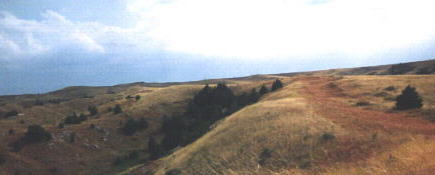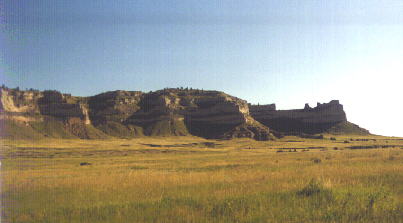The Oregon Trail in Western Nebraska
by Lisa Yungel
Many thanks to Lisa Yungel who saw our Oregon Trail pages and sent these
images and text!
Our trip moves east to west and you are seeing much of what the
emigrants saw in the same order.
 1. This panoramic picture was taken on the top of Windlass Hill before
entering Ash Hollow. The reddish strip of grass on the right side of the
picture is the grassy ruts of the Oregon Trail as it winds it's way across
the ridge; you can walk along these ruts for a few miles in
either direction. While the descent down Windlass Hill was considered scary
by the emigrants, due to the slope of the hill, they were willing
to risk crashing their wagons, losing belongings, and breaking bones in order
to take advantage of the spring, shade & beauty of Ash Hollow.
1. This panoramic picture was taken on the top of Windlass Hill before
entering Ash Hollow. The reddish strip of grass on the right side of the
picture is the grassy ruts of the Oregon Trail as it winds it's way across
the ridge; you can walk along these ruts for a few miles in
either direction. While the descent down Windlass Hill was considered scary
by the emigrants, due to the slope of the hill, they were willing
to risk crashing their wagons, losing belongings, and breaking bones in order
to take advantage of the spring, shade & beauty of Ash Hollow.
 2. There was a sod house or "soddy" at the edge of Windlass Hill in Ash
Hollow. While this is not the original, it is built on the original site of
a soddy that was often used by the emigrants as a makeshift post office.
Emigrants would leave letters & money for postage at the house for
relatives back in the East and hope that some eastward bound traveler
would take it "back to the States" with them.
2. There was a sod house or "soddy" at the edge of Windlass Hill in Ash
Hollow. While this is not the original, it is built on the original site of
a soddy that was often used by the emigrants as a makeshift post office.
Emigrants would leave letters & money for postage at the house for
relatives back in the East and hope that some eastward bound traveler
would take it "back to the States" with them.
3. This rock formation was appropriately named Chimney Rock; even
though what the pioneers saw was about 100 feet taller than what is
pictured, we can see how Chimney Rock got it's name. Chimney Rock was
the landmark that is mentioned in more emigrant diaries than any other
landmark along the Trail.
Emigrants were so fascinated by it that they
made side trips just to climb it and place their names as high up on the
Rock as possible. Unfortunately, Chimney Rock is made of a soft
sandstone and the names on the Rock eroded after only a few years.

4. As the emigrants approached Scott's Bluff, this was their view. By
now, however, they were used to these unusually shaped landmarks,
although the area surrounding Scott's Bluff was often referred to as "the
gardens" because of it's beauty.
5. In Scott's Bluff National Park are two examples of the types of wagons
used on the great trails west. The wagon on the left is a Conestoga
wagon, which was rarely seen on the Oregon Trail but quite common on the
Santa Fe Trail. The wagon on right is the type of wagon used on the Oregon
Trail; these wagons were smaller than the Conestoga wagon. Can you
imagine trying to fit your most valued possessions on a prairie wagon like
this one and travelling over 2000 miles across the country?
Follow the Trail... for more
images
Search The Global Classroom
Patricia A. Weeg
pweeg@shore.intercom.net
Return to Global Classroom
 1. This panoramic picture was taken on the top of Windlass Hill before
entering Ash Hollow. The reddish strip of grass on the right side of the
picture is the grassy ruts of the Oregon Trail as it winds it's way across
the ridge; you can walk along these ruts for a few miles in
either direction. While the descent down Windlass Hill was considered scary
by the emigrants, due to the slope of the hill, they were willing
to risk crashing their wagons, losing belongings, and breaking bones in order
to take advantage of the spring, shade & beauty of Ash Hollow.
1. This panoramic picture was taken on the top of Windlass Hill before
entering Ash Hollow. The reddish strip of grass on the right side of the
picture is the grassy ruts of the Oregon Trail as it winds it's way across
the ridge; you can walk along these ruts for a few miles in
either direction. While the descent down Windlass Hill was considered scary
by the emigrants, due to the slope of the hill, they were willing
to risk crashing their wagons, losing belongings, and breaking bones in order
to take advantage of the spring, shade & beauty of Ash Hollow.
 2. There was a sod house or "soddy" at the edge of Windlass Hill in Ash
Hollow. While this is not the original, it is built on the original site of
a soddy that was often used by the emigrants as a makeshift post office.
Emigrants would leave letters & money for postage at the house for
relatives back in the East and hope that some eastward bound traveler
would take it "back to the States" with them.
2. There was a sod house or "soddy" at the edge of Windlass Hill in Ash
Hollow. While this is not the original, it is built on the original site of
a soddy that was often used by the emigrants as a makeshift post office.
Emigrants would leave letters & money for postage at the house for
relatives back in the East and hope that some eastward bound traveler
would take it "back to the States" with them.


